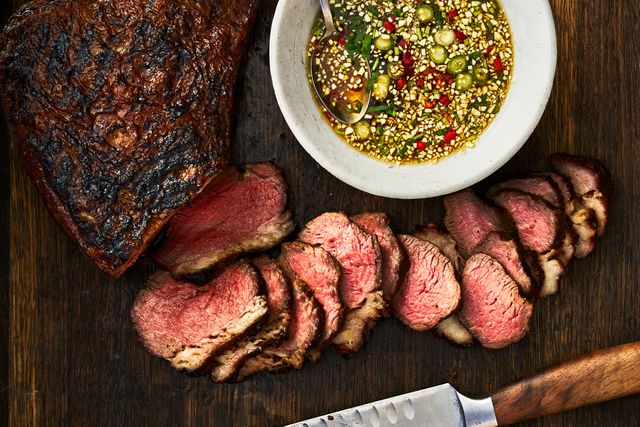Maybe you’ve asked for tri-tip at an East Coast grocery store only to be met with a blank stare. Or perhaps you’ve wondered what kind of cut to use for a steak tips recipe. When it comes to beef, the term “steak tips” doesn’t have just one meaning, and the labels you’ll see at stores and butcher counters are often regional jargon. Here’s everything you need to know about New England steak tips and tri-tip, a California favorite: how they’re alike and how each reflects a different corner of the U.S.
What are New England steak tips?
Steak tips or sirloin tips come from the sirloin flap, also known as flap steak or bavette, which is located on the bottom sirloin of the cow. Flap steak might be sold as one long, boneless piece of meat that can be sliced against the grain; or as smaller cubes of beef that are one to two inches in diameter.
In Boston and thoughout New England, steak tips can also refer to cubed sirloin tips (or sometimes flank or tenderloin tips) that are marinated then grilled for a quick-cooking and flavorful dish. Common marinades include Italian dressing and Worcestershire-based sauces.
“New England steak tips are sirloin tips,” says Ashley Lonsdale, ButcherBox chef-in-residence. “They were invented by butchers as a way to use and sell a potentially less appealing cut of beef.” While the exact origins of New England-style steak tips are unknown, they were a popular dish on Boston restaurant menus by the 1970s, according to Boston Magazine.
Steak tips can go by many names; at the butcher, you can specify that you’d like tips from the sirloin flap.
What is tri-tip?
Tri-tip is a cut from the “hind quarter of the animal, between the top sirloin and the bottom round,” explains Josh Turka, owner of 5th Quarter Butcher Shop in Waitsfield, Vermont. “It’s a triangular-shaped muscle, which is where it gets its name.” This boneless cut is usually 1 ½ to 2 ½ pounds, and can be cooked whole or sliced into individual steaks.
Popular in Central California, tri-tip is sometimes called a Santa Maria steak or California cut. It’s thought that in the 1950s, Santa Maria butcher Bob Schutz started selling the cut (it previously had been reserved for ground beef), and it soon became part of Santa Maria’s distinctive barbecue style, in which meat is grilled over an oak fire.
Tri-tip remains relatively hard to find outside of the West Coast, Turka says. It’s a limited cut, he explains, and because demand is so high in California many East Coast butchers will ship their tri-tip out West.
If you live on the West Coast or have access to a local whole-animal butchery, however, “tri-tip is a really great cut,” Turka says. “It’s relatively inexpensive, has nice fat marbles in it, and is pretty versatile to cook.”
Can you substitute sirloin tips for tri-tip?
Yes, you can substitute sirloin tips or tip steak for tri-tip and vice versa, though you may choose to marinade sirloin tips, which are generally leaner.
“Steak tips have a loose grain and do very well with a marinade, which adds flavor and improves texture and juiciness,” Lonsdale says. “Marinating and then grilling skewers of steak tips or braising steak tips are two of my favorite ways to prepare them. I prefer a yogurt marinade, which adds flavor and improves texture.”
“Steak tips have a loose grain and do very well with a marinade, which adds flavor and improves texture and juiciness.”
Tri-tip has more marbling and doesn’t need much to shine. Turka suggests seasoning tri-tip simply, grilling for 20 to 30 minutes over indirect heat, then searing the sides on high heat for a crisp finish. You can also slice tri-tip into individual steaks or even smaller steak tips; keep in mind that the grain runs in two different directions, so you’ll want to make sure you’re aligning your knife perpendicular to the linear patterns on the steak to make sure it isn’t chewy.
Some folks like to treat tri-tip as a mini brisket and smoke or braise it, just as you would a brisket or chuck roast. If you’d like to grill or smoke a whole roast and can’t find tri-tip, Turka suggests picanha, a similarly marbled cut that comes off the top sirloin and includes the fat cap, resulting in a juicy roast.
This article was written by Melissa Kravitz Hoeffner from Food & Wine and was legally licensed through the DiveMarketplace by Industry Dive. Please direct all licensing questions to legal@industrydive.com.







